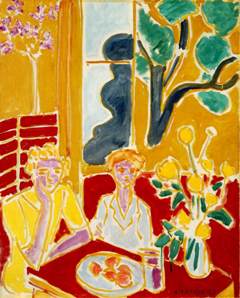Two Girls in a Yellow and Red Room
Two Girls in a Yellow and Red Room is a fictional artwork that does not correspond to a known painting or creation in the art world. As such, this article will provide a general overview of the themes and elements typically associated with artworks featuring similar descriptions, focusing on the use of color, composition, and the depiction of figures within an interior space.
Overview[edit | edit source]
Artworks depicting figures within interior spaces are a common theme throughout art history, offering viewers a glimpse into the private, intimate moments of the subjects' lives. Paintings that feature two girls in a room can explore a variety of themes, including friendship, sisterhood, the passage of time, and the complexities of youth. The choice of a yellow and red room for the setting can significantly influence the painting's mood and interpretation, as colors play a crucial role in art, conveying emotions and setting the tone.
Composition and Color[edit | edit source]
In a painting titled Two Girls in a Yellow and Red Room, the composition would likely be carefully constructed to draw the viewer's eye to the interaction between the two figures. The use of color is critical, with yellow often symbolizing warmth, light, and optimism, while red can represent passion, danger, or power. The juxtaposition of these colors can create a dynamic and emotionally charged environment, enhancing the narrative or thematic elements the artist wishes to convey.
Symbolism and Interpretation[edit | edit source]
The symbolism in such a painting can be rich and varied, depending on the cultural context, the artist's intentions, and the viewer's perceptions. The presence of two girls might symbolize a shared experience or relationship dynamic, with the room's colors highlighting the emotional or psychological aspects of their interaction. Interior scenes with figures often invite speculation about the subjects' thoughts and feelings, their relationship to each other, and their connection to the space they inhabit.
Art Historical Context[edit | edit source]
Throughout art history, interior scenes have been a popular subject for many artists, allowing them to explore light, color, and form in intimate settings. From the detailed domestic interiors of the Dutch Golden Age to the expressive, color-drenched rooms of the Post-Impressionist period, artists have found rich material in the depiction of indoor spaces. A painting like Two Girls in a Yellow and Red Room could draw inspiration from various art movements, incorporating elements such as the emotional depth and psychological complexity found in Symbolist works or the vibrant color and dynamic composition of Fauvist paintings.
Conclusion[edit | edit source]
While Two Girls in a Yellow and Red Room does not correspond to a specific known artwork, it represents a compelling concept that encompasses a range of artistic themes and techniques. The interplay of color, composition, and symbolism within such a painting offers endless possibilities for interpretation, reflecting the universal themes of human connection, emotion, and the beauty of the everyday.
Search WikiMD
Ad.Tired of being Overweight? Try W8MD's physician weight loss program.
Semaglutide (Ozempic / Wegovy and Tirzepatide (Mounjaro / Zepbound) available.
Advertise on WikiMD
|
WikiMD's Wellness Encyclopedia |
| Let Food Be Thy Medicine Medicine Thy Food - Hippocrates |
Translate this page: - East Asian
中文,
日本,
한국어,
South Asian
हिन्दी,
தமிழ்,
తెలుగు,
Urdu,
ಕನ್ನಡ,
Southeast Asian
Indonesian,
Vietnamese,
Thai,
မြန်မာဘာသာ,
বাংলা
European
español,
Deutsch,
français,
Greek,
português do Brasil,
polski,
română,
русский,
Nederlands,
norsk,
svenska,
suomi,
Italian
Middle Eastern & African
عربى,
Turkish,
Persian,
Hebrew,
Afrikaans,
isiZulu,
Kiswahili,
Other
Bulgarian,
Hungarian,
Czech,
Swedish,
മലയാളം,
मराठी,
ਪੰਜਾਬੀ,
ગુજરાતી,
Portuguese,
Ukrainian
Medical Disclaimer: WikiMD is not a substitute for professional medical advice. The information on WikiMD is provided as an information resource only, may be incorrect, outdated or misleading, and is not to be used or relied on for any diagnostic or treatment purposes. Please consult your health care provider before making any healthcare decisions or for guidance about a specific medical condition. WikiMD expressly disclaims responsibility, and shall have no liability, for any damages, loss, injury, or liability whatsoever suffered as a result of your reliance on the information contained in this site. By visiting this site you agree to the foregoing terms and conditions, which may from time to time be changed or supplemented by WikiMD. If you do not agree to the foregoing terms and conditions, you should not enter or use this site. See full disclaimer.
Credits:Most images are courtesy of Wikimedia commons, and templates Wikipedia, licensed under CC BY SA or similar.
Contributors: Prab R. Tumpati, MD

